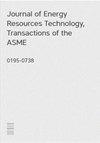二甲醚和矿物柴油喷雾雾化和蒸发特性的比较
IF 2.4
3区 工程技术
Q3 ENERGY & FUELS
Journal of Energy Resources Technology-transactions of The Asme
Pub Date : 2023-05-25
DOI:10.1115/1.4062619
引用次数: 0
摘要
二甲醚是一种新一代的替代燃料,可缓解压燃式发动机的冷启动问题。它具有更高的十六烷值,并且可以有效地导致优异的雾化和蒸发特性。这项计算研究比较了二甲醚和基准柴油在定容喷雾室中的喷雾。该模拟研究比较了由于二甲醚的适应性而提高的喷雾和蒸发特性。燃料特性对喷雾雾化和蒸发特性有很大影响。本研究基于雷诺平均Navier-Stokes框架中采用的欧拉拉格朗日方法。通过模拟获得的液体喷雾穿透与二甲醚和基准柴油的实验结果非常吻合。由于两种测试燃料的燃料特性完全不同,因此分别对柴油和二甲醚的喷雾模型常数进行了调整。这些调整后的模型用于模拟固定燃料喷射时间和环境条件下的二甲醚和柴油喷雾。结果表明,由于二甲醚的闪蒸,二甲醚的喷雾穿透长度低于模具。由于二甲醚具有较低的粘度、密度、表面张力和较高的蒸发速率,形成了直径较小的液滴。在开始注射二甲醚之后,Sauter平均直径的减小相当剧烈。与二甲醚相比,柴油喷雾表现出延迟的雾化和蒸发。两种燃料的蒸汽穿透长度几乎相同;然而,二甲醚的蒸汽质量分数高于基准柴油。二甲醚喷雾显示出优异的喷雾雾化和改善二甲醚液滴的蒸发。本文章由计算机程序翻译,如有差异,请以英文原文为准。
Comparative Spray Atomization and Evaporation Characteristics of Dimethyl Ether and Mineral Diesel
Dimethyl ether is a new-generation alternative fuel to mitigate cold-start issues in compression ignition engines. It has a higher cetane number and can efficiently lead to superior atomization and evaporation characteristics. This computational study compares Dimethyl ether and baseline diesel sprays in a constant-volume spray chamber. This simulation study compares spray and evaporation characteristics en-hancement due to Dimethyl ether adaptation. Fuel properties greatly influence spray atomization and evaporation characteristics. This study is based on the Eu-lerian-Lagrangian approach adopted in the Reynolds-averaged Navier-Stokes framework. The liquid spray penetration obtained by simulations matched well with the experimental results of Dimethyl ether and baseline diesel. Spray model con-stants were tuned for diesel and Dimethyl ether separately, as the fuel properties of both test fuels are completely different. These tuned models were used to simulate Dimethyl ether and diesel sprays at fixed fuel injection timings and ambient condi-tions. Results showed a lower spray penetration length for Dimethyl ether than die-sel because of the flash boiling of Dimethyl ether. Smaller diameter droplets formed due to Dimethyl ether's lower viscosity, density, surface tension, and higher evapora-tion rate. The reduction in Sauter mean diameter was quite sharp after the start of injection for the Dimethyl ether. Diesel spray showed retarded atomization and evaporation compared to Dimethyl ether. The vapour penetration length of both fuels was almost the same; however, the vapor mass fraction was higher for Dime-thyl ether than baseline diesel. Dimethyl ether spray showed superior spray atomi-zation and improved evaporation of Dimethyl ether droplets.
求助全文
通过发布文献求助,成功后即可免费获取论文全文。
去求助
来源期刊
CiteScore
6.40
自引率
30.00%
发文量
213
审稿时长
4.5 months
期刊介绍:
Specific areas of importance including, but not limited to: Fundamentals of thermodynamics such as energy, entropy and exergy, laws of thermodynamics; Thermoeconomics; Alternative and renewable energy sources; Internal combustion engines; (Geo) thermal energy storage and conversion systems; Fundamental combustion of fuels; Energy resource recovery from biomass and solid wastes; Carbon capture; Land and offshore wells drilling; Production and reservoir engineering;, Economics of energy resource exploitation

 求助内容:
求助内容: 应助结果提醒方式:
应助结果提醒方式:


